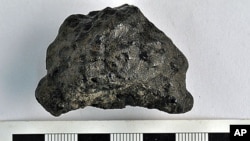Scientists have confirmed that a rocky meteor that broke apart in the atmosphere and crashed last July came from Mars. The space-faring stones, perhaps blasted free of the Red Planet by an ancient planetary collision, are the first documented Martian debris to fall to Earth in 50 years. The rare meteorites have been scooped from the African sands by collectors and dealers, who are selling them for thousands of dollars.
The Martian meteor's fiery fall through Earth’s atmosphere last year was seen by Moroccan nomads and military personnel. At about 2:00 a.m. local time on July 18, they were startled by sonic booms and a fireball that one witness said lit the night sky with a yellow and then a green glow, before breaking into pieces and disappearing into the remote desert.
Pieces of that meteor were not located until October, when nomads found the black, heat-scorched stones near the Moroccan village of Tissint. Soon, samples were collected for analysis by scientists, including the international committee of experts that confirmed the meteorites' Martian origin.
Experts say the meteor, officially named Tissint by The Meteoritical Society, probably took millions of years to get here after an asteroid or some other large object collided with the Red Planet and blasted thousands of chunks of Martian rock into space.
Chunks of the meteor that struck Earth totaled 6.8 kilograms, with the largest weighing almost a kilogram.
Christopher Herd, a professor of Earth & Atmospheric Sciences at the University of Alberta in Canada, headed the committee of scientists, including some from the U.S. space agency, NASA, that verified the meteorites came from Mars.
Herd says that compared to the four previous meteorites known to be of Martian origin, pieces of the Tissint meteor are especially good specimens because they were found shortly after landing in the Moroccan desert.
“It’s really fresh," said Herd. "It’s really glassy looking because it’s only been on the ground for a few months in a nice dry environment. So, it hasn’t been affected in a big way by rain or even wind, that sort of thing that does occasionally happen in the desert.”
As soon as Moroccan nomads located the impact site, meteorite hunters moved in to snatch up pieces of the valuable rocks, which have been selling for 10 times the price of gold. Museum curators and scientists, including Herd, scrambled to buy the meteorites before all of them went to the highest bidder.
Herd says the first verified Mars rock to strike Earth in half-a-century offers scientists a rare opportunity to learn about the Red Planet.
“We have an incredible array of technology at our disposal now, as opposed to 50 years ago, where we can analyze this rock in amazing detail," he said. "Plus, because it’s only been on Earth for a few months, [that] means that it hasn’t been tremendously affected by weather. So, what we analyze in these rocks is more likely to be Martian than from the Earth.”
Experts say that only about 100 kilograms of verified Martian rocks are known to exist in the world. But none is in such high demand as last year's fiery gift from the Red Planet.











